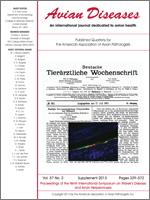Marek's disease (MD) is a highly transmissible, herpesvirus-associated malignancy of chickens and turkeys caused by Marek's disease virus (MDV). MD is currently controlled through the use of nonsterilizing vaccines composed of antigenically related, apathogenic herpesviruses Mardivirus 2 (MDV-2), Meleagrid herpesvirus 1 (herpesvirus of turkeys, HVT), or attenuated MDV-1 strain CVI988 (Rispens). Since the mid-1960s, field strains of MDV have increased in virulence, due, in part, to the widespread use of vaccines since the early 1970s. One mutation that we have identified common to very virulent field strains (vv and vv MDVs) since the 1990s has been a mutation in the UL1 gene, encoding glycoprotein L (gL). This mutation, a 12-nucleotide (nt) deletion in the signal peptide of gL, has been associated with increased virulence and decreased vaccine protection in the context of challenge with a vv MDV, strain TK. To determine whether this mutation alone was sufficient to confer increased virulence, we introduced this mutation into the transmission-competent pRB-1B bacterial artificial chromosome (BAC) using two-step, Red-mediated recombination. The resulting mutant, pRB-1BgLΔ, was tested for changes in replication in cell culture using multistep growth curves, plaque size analysis, viral burst analysis, and the ability to compete with the parental virus when co-transfected at different ratios and sequentially passaged. In addition, we examined this mutant for changes in pathogenicity in inoculated and contact-exposed unvaccinated and vaccinated chickens. Our data show minor differences in plaque sizes in cell culture, but no discernible changes in the infection of specific-pathogen-free (SPF) leghorn chickens. We therefore conclude that although this mutation is indeed common to MDV field strains isolated in the eastern United States, it is insufficient to confer increased virulence or loss of vaccine protection previously observed for a vv MDV strain having this mutation.
Una deleción en el gene de la glicoproteína L de cepas de campo del virus de la enfermedad de Marek en los Estados Unidos es insuficiente para conferir mayor patogenicidad a un cromosoma bacteriano artificial basado en la cepa, RB-1B.
La enfermedad de Marek (MD) es una enfermedad tumoral de pollos y pavos que es altamente transmisible asociada a un herpesvirus y es causada por el virus de la enfermedad de Marek (MDV). La enfermedad de Marek está actualmente controlada a través del uso de las vacunas compuestas de herpesvirus no patógenos relacionados antigénicamente, Mardivirus 2 (MDV-2) y Meleagrid herpesvirus 1 (herpesvirus de los pavos, HVT), o con la cepa atenuada CVI988 (Rispens). Desde mediados de la década de los 1960s, las cepas de campo del virus de Marek han aumentado su virulencia, debido en parte al uso generalizado de vacunas desde principios de los años 1970s. Se ha identificado una mutación común con las cepas de campo altamente virulentas (vv y vv MDV) desde la década de los 1990s, ha sido una mutación en el gen UL1, que codifica la glicoproteína L (gL). Esta mutación, que es una deleción de 12 nucleótidos (nt) en el péptido señal de la glicoproteína L, se ha asociado con aumento en la virulencia y con la disminución de la protección de vacuna ante un desafío con la cepa muy virulenta plus, cepa TK. Para determinar si esta mutación por sí sola era suficiente para conferir mayor virulencia, se introdujo esta mutación en un cromosoma bacteriano artificial (BAC) denominado pRB-1B que es competente en su transmisión, utilizando una recombinación mediada por Red de dos pasos. Se analizó el mutante resultante, pRB-1BgLΔ, para determinar los cambios en la replicación en cultivo celular mediante curvas de crecimiento de pasos múltiples, análisis del tamaño de las placas, análisis de estallido viral, y la capacidad para competir con el virus progenitor cuando se co-transfectaron en diferentes pr





